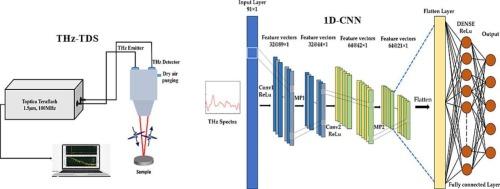利用反射几何中太赫兹时域光谱的一维卷积神经网络技术对二次炸药进行分类。
IF 4.6
2区 化学
Q1 SPECTROSCOPY
Spectrochimica Acta Part A: Molecular and Biomolecular Spectroscopy
Pub Date : 2025-09-11
DOI:10.1016/j.saa.2025.126924
引用次数: 0
摘要
太赫兹时域光谱(THz-TDS)是识别爆炸物的一种重要的光谱技术。太赫兹数据与机器学习模型的集成可以快速识别和分类爆炸分子。本文报道了RDX、HMX、TNT、PETN、Tetryl等优质炸药在反射几何上的太赫兹时域谱研究。我们记录了炸药在0.2太赫兹-3太赫兹频率范围内的吸收光谱和折射率。采用主成分分析(PCA)从数据中提取基本特征。下一步,基于吸收光谱、折射率和快速傅里叶变换(FFT)等太赫兹光谱数据,使用支持向量机(SVM)、k近邻(KNN)和随机森林(RF)等监督机器学习算法以及主成分分析对这些爆炸物进行分类。有监督机器学习模型实现的预测精度在90%以上。此外,采用一维卷积神经网络(1D-CNN)进行分类,预测准确率超过95%,优于传统的机器学习模型。该研究表明,太赫兹光谱和1D-CNN的结合被证明是一种有效而实用的爆炸物识别工具。本文章由计算机程序翻译,如有差异,请以英文原文为准。

Classification of secondary explosives with a 1D convolutional neural network technique using terahertz time-domain spectroscopy in reflection geometry
Terahertz time-domain spectroscopy (THz-TDS) stands out as a prominent spectroscopic technique ideal for identifying explosives. The integration of THz data with machine learning models enables rapid identification and classification of explosive molecules. The paper reports the terahertz time domain spectral study of premium explosives such RDX, HMX, TNT, PETN & Tetryl in reflection geometry. We have recorded the absorption spectra and refractive index of the explosives in the frequency range of 0.2 THz–3 THz. Principal component analysis (PCA) was employed for extracting the essential features from the data. In the next step, supervised machine learning algorithms such as support vector mechanism (SVM), K-Nearest neighbor (KNN), and Random Forest (RF) along with principal component analysis were used for the classification of these explosives based on the terahertz spectral data such as absorption spectra, refractive index and Fast Fourier's transform (FFT). The prediction accuracies achieved by supervised machine learning models were above 90 %. In addition, a one-dimensional convolutional neural network (1D-CNN) was implemented for classification, which has outperformed traditional machine learning models by achieving prediction accuracies greater than 95 %. The study has demonstrated that a combination of terahertz spectroscopy and 1D-CNN proves to be an efficient and practical tool for the identification of explosives.
求助全文
通过发布文献求助,成功后即可免费获取论文全文。
去求助
来源期刊
CiteScore
8.40
自引率
11.40%
发文量
1364
审稿时长
40 days
期刊介绍:
Spectrochimica Acta, Part A: Molecular and Biomolecular Spectroscopy (SAA) is an interdisciplinary journal which spans from basic to applied aspects of optical spectroscopy in chemistry, medicine, biology, and materials science.
The journal publishes original scientific papers that feature high-quality spectroscopic data and analysis. From the broad range of optical spectroscopies, the emphasis is on electronic, vibrational or rotational spectra of molecules, rather than on spectroscopy based on magnetic moments.
Criteria for publication in SAA are novelty, uniqueness, and outstanding quality. Routine applications of spectroscopic techniques and computational methods are not appropriate.
Topics of particular interest of Spectrochimica Acta Part A include, but are not limited to:
Spectroscopy and dynamics of bioanalytical, biomedical, environmental, and atmospheric sciences,
Novel experimental techniques or instrumentation for molecular spectroscopy,
Novel theoretical and computational methods,
Novel applications in photochemistry and photobiology,
Novel interpretational approaches as well as advances in data analysis based on electronic or vibrational spectroscopy.

 求助内容:
求助内容: 应助结果提醒方式:
应助结果提醒方式:


